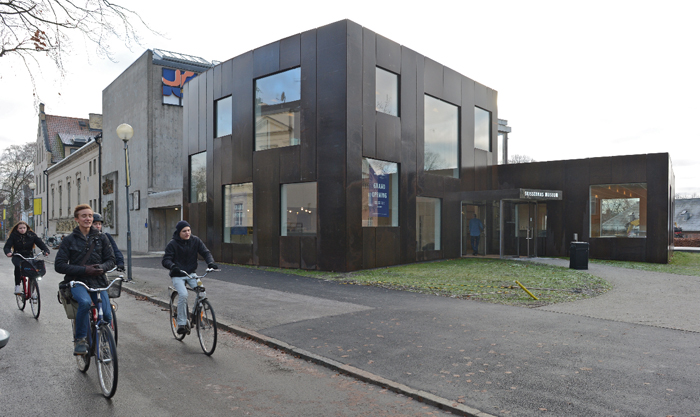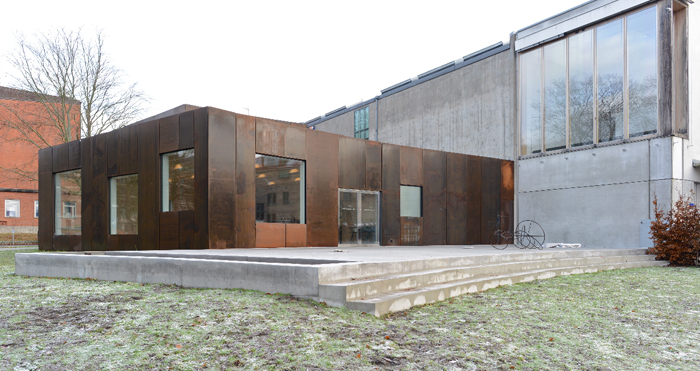Museum of Sketches for Public Art or Museum of Artistic Process and Public Art


On 27 and 28 January 2017, the Museum of Sketches for Public Art was reopened on Finngatan 2. A new entrance, a museum shop and not least a restaurant have been added. The extension, designed by the architect duo Elding Oscarsson, is made of concrete and rust red Corten steel. Two anonymous donors account for a large part of the funding. The new building has already been given a nickname that refers to its many square windows: “Paintings in an exhibition”.
The task of the museum has always been namely: to show how an artwork is created and changed on its way to its finished form.
The collection is international and constantly growing. Sketches, models, sculptures and other types of preliminary studies of artwork are shown here with the intention of documenting the creative process involved prior to becoming public art. The museum is unique in the world.
It started in a gym
This is not the first time the Museum of Sketches for Public Art has changed. Its story begins in a gym and ends in the newly designed premises. The original creator, Ragnar Josephson, was a professor at Lund University between 1929 and 1957. He had collected a large number of sketches through donations from several famous artists. In 1934, he decided to show these at a special exhibition held at the Skåne Art Museum, which was then housed at the top of the university building. Amongst these sketches were some donated by Prince Eugene, Einar Forseth and Isac Grünewald. The following year, works in this exhibition became the basis for what was then called the Archive for Decorative Swedish Art. (The term decorative art at that time referred to what today is called site-specific art or public art).
The museum of sketches was born.
In 1941, the ever-growing collection was given its first dedicated location, a gymnasium dating from 1882 that previously had been used by a teachers’ seminary. The hall became the core of the newly created museum. Now the public were able to have access at regular times to what was commonly known as the Archive Museum.
However, space in the hall proved insufficient, so Professor Josephson purchased nine barracks from the Swedish Army at Revingehed, which were attached to the existing museum building.
In 1949, the new premises were completed.
The Lund-based architect for the project was Hans Westman. He was also responsible for adding what came to be called the “Swedish Hall” ten years later.
Archive for Decorative Art becomes the Museum of Sketches for Public Art
In 1984, the museum celebrated its 50th year and adopted the official name Archive for Decorative Art. The “Swedish” epithet was now removed from the name, as some of the artwork being shown came from far beyond the borders of Sweden. At the anniversary in 1991, the name once again changed and it became Museum of Sketches for Public Art.
In 1988, it was time for yet a new extension, this time out towards the street Sölvegatan. The architects responsible were Karl Koistinen and Göran Hellborg. The artistic advisor and originator of the facade decoration was Sivert Lindblom.
In the early 2000’s, the museum closed for a few years. The army barracks were demolished, and a new hall was added with a large window facing out towards a newly created sculpture park, designed by Birre Skoglund together with Johan Celsing, the architect responsible for the latest addition to the museum. The opening took place in 2005.

The new name – Museum of Artistic Process and Public Art
And now this accommodating museum has reopened once again.
The former courtyard is now a room with a mirrored roof. Temporary exhibitions as well as events of various kinds will be arranged here, a tradition from the old “Sketches”.
The Museum of Sketches proved inaccessible in several ways. This was partly due to it being a labyrinthine of a building and partly due to the wealth of its collections. (Over 30,000 sketches and models are housed here!).
Visiting the museum is somewhat of an adventure and you never know what you might encounter.
This is the charm of the museum. New discoveries await!
Text: Ingrid Meijling, photo: Claes Wahlöö
